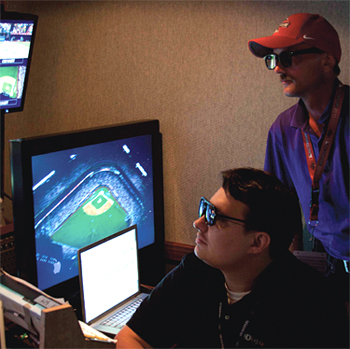2D to 3D: What's the Problem?
HOLLYWOOD
There has been a lot of controversy over new technologies that can convert 2D material into 3D for either theatrical or TV release. Yet at an August 17 seminar hosted by iHollywood Forum West Post Digital in Santa Monica, Calif., the consensus of the panel was that when done properly, 2D to 3D conversion can actually provide a better result than original stereoscopic 3D videography.
"People who say that one process is more 'pure' over the other don't know what they are talking about," said Rob Hummel, CEO of Prime Focus, North America. "This [pointing at his eyes] is the only reality."
The conversion process actually puts more control in the filmmaker's hands. "Cameron researched this technology for a decade, and did it really well," Hummel said subsequent to the seminar. "The advantage of stereoscopic conversion during post is that you can make a lot of decisions after you have photographed the image, and you avoid many of the pitfalls of shooting with a twin lens camera."

Steve Nowalk, HDlogix Chief Architect(R) and Will Gaddy, HDlogix CTO, at the 2010 MLB All Star Game, where HDlogix's Image IQ 3D 2D-to-3D converter was used to convert footage. Photo by HDlogixAUTOMATED HELP
Although a hands-on conversion will always benefit from the input of human creativity, in order to control the costs many are looking for automated help. This summer's release of Alexandre Aja's "Piranha 3D" from Dimension Films incorporated significant 2D to 3D conversion from HDlogix, Inc. using their ImageIQ3D process. They collaborated as a technical partner to Identity FX, using HDLogix's Image IQ3D process.
"We view 3D as a natural extension of HD," said HDlogix CEO Jim Spinella. "If the conversion from 2D to 3D is done properly, it should be indistinguishable from original 3D acquisition."
If the plans of 3D broadcasters work out, 3DTV could become a vast outlet for 2D-3D conversion. Increasingly, among the 15 content distributors hoping to establish 24/7 3D broadcast channels globally in the near future, many are looking toward 2D to 3D conversion to provide the material to fill their schedules. Yet, while the labor-intensive rotoscoping processes used by 3D feature film makers can cost $50,000 to $100,000 per minute to achieve the results they desire, TV producers will necessarily have to rely on more automated, real-time approaches.
"Television is a voracious beast and needs everything it can get," said Bernie Laramie, former CEO of Stereoscope in Burbank, Calif., that provides 2D to 3D conversion services and currently producing the independent film "Air Racers 3D: Forces of Flight." "As the real time 2D to 3D for non-theatrical release develops, the costs are bound to come down to the level of TV budgets," he said.
NO 'MAGIC BOX'
One of the best real-time 2D to 3D conversion technologies is the standalone IF-2D3D1 Stereoscopic Image Processor that JVC launched at the 2010 NAB Show. As good as it is, Dave Walton, assistant vice president of marketing communications at JVC, doesn't want to raise unwarranted expectations.
"There is no magic box for 2D to 3D conversion," Walton said. "But given that, we can provide high-quality 2D to 3D conversion in a single rackmount unit. It can be a valuable asset for post production professionals to take some of the work out of the manual rotoscoping process."
However, Fred Blurton, an independent producer/director who has been working in 3D since 2008, had the opportunity to experiment with JVC's IF-2D3D1 for over a week and is less reticent about his praise.
"I ran everything through that box I could get my hands on," Blurton said, "including scenes from the 2D Blu-ray disk of 'Avatar' and I found it's amazingly impressive. I even ran my own 2D indie production, 'Osso Bucco,' through the system, and people asked how I could possibly have afforded the professional 3D conversion processes. 70-80 percent of the movie looked great with little tweaking."
Several 3DTV manufacturers have announced they will be including 2D to 3D conversion capabilities in upcoming consumer-grade home theater displays, including Samsung, Hyundai and LG. Even Panasonic, which once declared they would never adopt it, said in August that its Viera GT25 series of 3DTVs, the 42-inch TC-P42GT25 and 50-inch TC-P42GT25 will have 2D to 3D processing built in.

JVC IF-2D3D1 stereoscopic image processor
Many of them will not release details on the technology they have either developed in-house or licensed from others, but at least Samsung and Hyundai are utilizing real time 2D-3D conversion circuitry from DDD in Santa Monica, Calif.
"We also are pursuing other development agreements with other set-top box manufacturers and DTV SoC [system on chip] producers," said Chris Yewdall CEO of DDD. "During a recent meeting with a well-known TV manufacturer in Taiwan we ran the trailer from 'Avatar' on a 55-inch polarized 3DTV through our real time TriDef 3D conversion process and their 3D image quality expert insisted we were actually showing them the original 3D footage. He even got fairly insistent about it."
DDD estimates that if TV networks decide to adopt their technology, the price of converting a one-hour episodic (with 45 minutes of content) could come down to $25,000 if they agree to a 40-hour minimum. Under a 500-hour contract, the cost could get as low as $10,000 per hourly episode.
The professional video industry's #1 source for news, trends and product and tech information. Sign up below.
